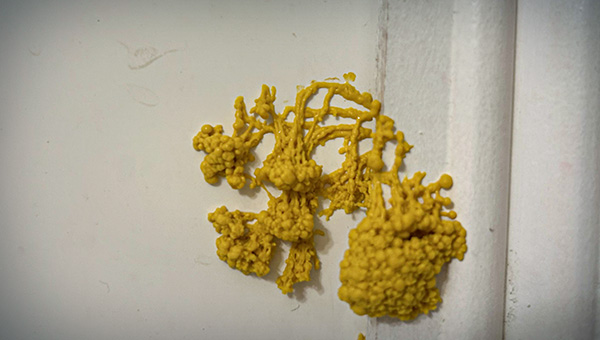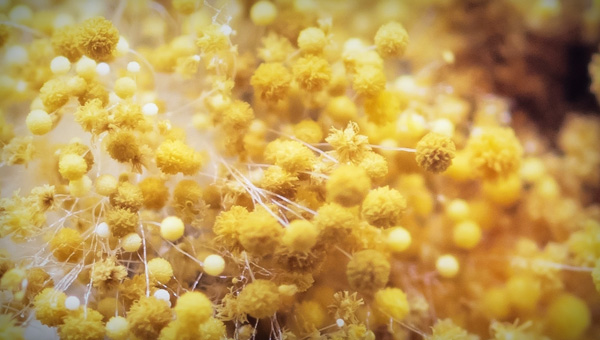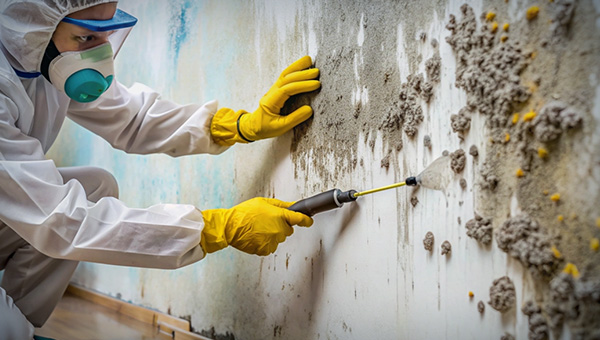
There are around 300 distinct mold types with various colors that can be found in houses. You undoubtedly have a lot of questions about yellow mold, sometimes called slime mold, if it has been discovered in your home. These questions likely center on what it is, how it got there, and how to get rid of it.
Like most other types of mold, yellow mold is a fungus that breaks down organic components. As a result, three conditions must be met for yellow mold to survive: organic material, humidity, and the ideal temperature. Continue reading to discover more about yellow mold and how to get rid of it.
Yellow mold is sometimes called slime mold because, at first impression, the colony resembles a yellow slime. It is a fungus that often flourishes in dimly lit, humid environments. Some types of yellow mold prefer dry, dark conditions over moist or warm temperatures to thrive.
There are a variety of mold species that appear yellow, some of which are hazardous or well-known to ruin wood. A yellow mold infestation is typically easy to spot since the mold's color is frequently vivid and challenging to ignore. One of the most prevalent mold species that is known to cause allergies and other respiratory problems is Aspergillus yellow mold. Other often encountered species of yellow mold include Fuligo septica, Cladosporium, Mucor, and Epicoccum Nigrum.
Early-stage yellow mold is a common household issue that thrives in damp, poorly ventilated areas. But can mold be yellow? Yes, yellow mold often appears as a powdery or slimy substance and can be found on various surfaces, including wood, tiles, and drywall. Common species like Aspergillus and Serpula lacrymans frequently make their debut in bathrooms, basements, or kitchens where moisture is abundant.
The texture of yellow mold varies: it may resemble soft fuzz, granular dust, or even a slimy layer. What does yellow mold look like in its early stage? It is usually pale or mustard-colored, with irregular growth patterns that follow damp areas. In specific settings, like a bathroom, yellow slime mold might form in corners or along grout lines due to persistent humidity.
Yellow mold spores often begin as tiny, scattered patches. Inspect high-moisture areas like the bathroom, where yellow slime mold is common. Look for faint discoloration, chalky residues, or slimy streaks along tiles or shower seals. On wood, yellow mold on wood may appear more embedded, with a slightly gritty or velvet-like texture.
Differentiating yellow mold from other substances is critical. Dust lacks the sticky or slimy feel of mold, while pollen is usually finer and dry. If discoloration lingers after cleaning or spreads quickly, it's likely mold rather than dirt or stains.
Besides appearance, yellow mold often signals its presence with an unpleasant musty odor, especially in bathrooms or basements. Persistent dampness, water stains, or condensation can also indicate mold-friendly conditions. If you see recurring yellow patches after cleaning, those are likely yellow mold spores regenerating.


In its early stages, yellow mold tends to be faint, localized, and easy to overlook. Over time, it becomes darker, spreads more aggressively, and may develop additional textures like thicker slime or crusty layers. Advanced-stage mold often penetrates surfaces like wood, requiring professional removal.
Catching yellow mold early prevents deeper infestations and costly damage. For instance, yellow mold on wood can cause structural weakening if left unchecked. Additionally, advanced mold releases a higher volume of spores, increasing health risks like allergies or respiratory issues. Cleaning up early-stage mold is significantly easier and safer, especially in areas prone to persistent humidity like bathrooms.
Spotting yellow mold early - whether as yellow slime mold in the bathroom or faint discoloration on wood - ensures your home stays safe, dry, and healthy.
Mold reproduces by releasing tiny spores. These spores are comparable to plant seeds, although they are considerably smaller and are easily dispersed by wind and water. By attaching onto anything, such as your clothes or pets, they may also move from one area to another across long ranges.
Doors, windows, vents, and HVAC systems that are left open can all let yellow mold spores into your house. Mold will grow when spores fall on areas with an overwhelming moisture level, such as those that may have had leaks or floods. A lot of construction materials provide the ideal conditions for yellow mold to thrive. Yellow mold may develop more readily on wet cellulose materials, such as ceiling tiles, wood, and wood products.
Mold spores can persist in surroundings that do not favor the typical growth of mold. However, they will remain dormant, and can begin to develop immediately when placed in an environment with adequate water, food, temperature, and oxygen. For energy, mold relies on living matter. Mold grows on substances that it can consume. These compounds are transformed into simple, absorbable molecules by the production of digestive enzymes. This is how mold gets the necessary nutrients for its growth.
If your home has water stains or yellowish slime patches on the walls, ceilings, or wood floors, or if you see paint or wallpaper crumbling or cracking, mold problems are present. Mold may not appear in prominent places; if you have a musty odor, an allergy, or a chronic cough, there may be hidden mold in your home. If you see any of these symptoms, you should get assistance immediately since the mold will expand.

There are many different types of yellow mold, some of which are poisonous and may be very bad for your health if you come in contact with them or breathe in their spores. Given that you cannot tell what kind of yellow mold you have simply by looking at it, it is advised that you avoid contact with mold in general and consult a mold expert's help as soon as you discover any indications.
If you see it developing within your home, especially the yellow mold on wood or any other structure, you should get rid of it right away to stop the infestation from getting worse.
Yellow mold may not provide a threat to healthy individuals with strong immune systems, but it poses a risk to weaker individuals including infants, pets, and those with respiratory conditions or weakened immune systems.
Some types of yellow mold are known to aggravate pre-existing respiratory conditions and induce allergies. Overexposure to mold can cause a variety of symptoms, such as headaches, coughing, sneezing, vertigo, rashes, irritation, etc. See your doctor if you are having any serious allergic reactions or illnesses and look for a professional long-term mold removal solution.
Yellow mold may harm your health, the quality of the air you breathe, and your property. Locate a yellow mold infestation soon, and clean it up right away to prevent these issues.
First of all, you need to identify the places where mold is present. You can typically find yellow slime bathroom mold. Moreover, you may also witness yellow mold on ceiling, in basement, in crawl space, and other such places.
There are various techniques to tackle mold. If the mold is minor, the issue can be resolved by scraping the observable mold with a brush and immediately spraying anti-microbial chemicals over it. But, it is only effective for small areas and is just a temporary solution since mold may reappear.
To get rid of the stains, you may also consider painting over the mold, but this will not get rid of it or stop it from growing. You may also consider using bleach, baking soda, sanitizer, or other chemicals to kill the mold, although doing so may present health risks.
Despite the fact that each method efficiently addresses mold in its own way, they are still not the best choices since mold may resurface. In order to prevent mold damage, it is advisable to get experts to help with mold removal and employ mold remediation services.
The fact that mold is difficult to remove is one of the main reasons you should contact a professional mold treatment service. You could believe you are done after getting some gloves, cleaning supplies, and DIY techniques, only to find that the mold has grown back.
You could not completely eradicate the mold in your home if you simply clean the parts that are clearly apparent. You will not need to worry and may expect a permanent solution if you employ a mold removal service. They will use mold-detecting tools to find all contaminated places.
Only certified mold professionals are equipped with the mold decontamination equipment needed for cleanup to get the job done effectively. The method of mold removal is very delicate since, if improperly handled, the majority of the mold will spread and develop further. As a result, only a professional service can do it carefully.

Mold experts employ expensive, specialized mold decontamination equipment for mold removal including air scrubbers, HEPA vacuums, commercial-grade dryers, particle counters, air sprayers, humidity sensors, and other handheld equipment. They all contribute to the mold eradication procedure being completed more effectively while regular handymen will not have all of these tools. How long does it take to Remediate mold? Based on the amount, intensity, and area of mold growth, mold remediation normally takes three to seven days. Getting back to normal life, though, can take more than a week.
Mold is present in practically every color. The most prevalent mold colors are black and green. Moreover, you may also find mold in yellow, orange, purple, red, or in a combination of all these colors.
You may wish to leave during the work and for 48 hours after the mold decontamination procedure is complete in order to safeguard your well-being. You could still be able to live in the remaining parts of the house in some situations where only a section of the house is locked off for decontamination.
Yellow mold is toxic, particularly for children, pets, individuals who have breathing problems, and even healthy adults if they are exposed to it for an extended length of time. Yellow mold can potentially lead to severe diseases if it is not totally eliminated from your home.
Yellow mold may be eliminated from the soil as soon as it appears by removing it from the top 2 inches of the plant's soil. You may also repot the plant, use a natural fungicide, and cut off dead branches and leaves to get rid of yellow mold in the soil.
Windowsill mold can occasionally develop harmful mycotoxins that can make you sick. Normal windowsill mold does not represent a significant threat, but it can set off allergies that have irritating side effects.
Although mold on ceiling will not kill you, it is undoubtedly dangerous to both human health and a house's structural stability. Mold can cause serious side effects and allergies if you are exposed to it for an extended period of time. Additionally, your ceiling's paint or even the building itself might be ruined.
Some strains of yellow mold dangerous are hazardous to your health, and they can be difficult to recognize. To avoid further mold damage and contamination, you should get expert assistance for the removal of any yellow mold you see developing in your house.
Call for a free consultation with a specialist if you are worried about mold growing in your house and need a long-term fix. If you are having issues with yellow mold in your home, FDP Mold Remediation has you covered. To make sure that your property is maintained secure and mold-free, our team will examine, treat, and offer you mold remediation services, including detection, testing, consulting, and mold removal plan.
To guarantee that you receive the greatest services, the specialists on our teams are all certified, have years of expertise in the industry, and utilize top-of-the-line tools. You may be confident and expect an immediate and long-lasting remedy for mold issues when you choose us as your mold treatment company.



